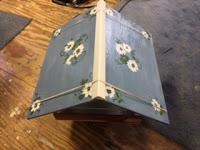How to make a Table Nightlight with a gourd
How to make a table night light or Christmas decorations using Proxxon Mini tools.
This is a fun project and not too difficult. The Proxxon tools make this an enjoyable project for even newbies with gourds.
First decide on a gourd you want to use. It helps and removes the step of sanding and leveling the gourd, so it sets flat on a table. You are going to create a scene inside the gourd. Topic is your choice, only limited by the size of the gourd. Choose holiday, everyday life, fantasy, your imagination is the only limit for the design.
So lets get started.
Material List
1.Gourd of appropriate size
2.Tools to clean inside of gourd/ can be a scraper a cleaning ball, sandpaper of variable grit,
3.Jigsaw to cut the gourd with. I use my Proxxon.( Makes cutting a breeze)
4.Large Tea light, mine changes colors @hobby Lobby
5. Glue to secure the tea light.
6.Paint ( I used Plaid Folk Art on this Gourd. It's rich in pigment and provides good coverage.
7.Sealer, matt or fixative I use Krylon spray for outside of gourd. Use after painting and before making scene inside. (prevents damaging paints prior to completing.
8.Whatever material you plan on using to place in the interior of the gourd.
Safety Tips
When working with gourds always use a face mask or a respirator to protect your lungs when cutting or sanding.
Steps to complete this project:
1. Decide what is the front of your gourd and where it sits best. I use a white pencil to draw a axis line down the middle of the gourd. This keeps the opening in line with the front. Then draw a line though the middle of the axis line as to how wide its going to be. Draw the shape for the opening.


2. Ok you're ready to cut. With the Proxxon Jig Saw it is a breeze. This tool is so light and easy to use. Being an older female, it is perfect for me. Drill a small hole inside of the cut out of the opening then you can use your Proxxon Saw to cut out the opening


2. Clean out all of the seeds and skin or fluff on the inside of the gourd. I use a ball sander or any scraper and or sandpaper that will help me loosen and remove the inside mess until it is smoothed to the shell of the gourd..
3. Choose where you are going to place the tea light on your gourd. This gourd made that easy for me as I could place it on the bottom and it still sat perfectly. ( I have had to place them on the side .)
To cut the hole draw a ring around the bottom of light that is the size hole you are going to want. you can cut it with your Proxxon mini jig saw or you can purchase a hole cutter to go on the end of a drill if you don't already have one.
TIP Paint the tea light with the same color as the gourd will make it less intrusive if you are placing it on side or top of gourd.
I chose a nativity for this lamp's story, and am going to paint the inside and outside to convey the lamps story.
4. I paint the inside and outside of the gourd. For this gourd I am using a very dark blue both inside and out. I used Ink spot 2925 for the blue base and all over the entire gourd. I then use a fixative or matte spray to protect the paints while I work on the next steps.
5. Free hand or put pattern for wise men on gourd.
6. Then using Plaid Folk art paints on the outside I painted three wise men traveling to visit the newborn Jesus. I used Plaid Steal Gray2561 on the wise men for shadow figures on the back of the gourd. Looks great on the dark background.
6. Then using Plaid Folk art paints on the outside I painted three wise men traveling to visit the newborn Jesus. I used Plaid Steal Gray2561 on the wise men for shadow figures on the back of the gourd. Looks great on the dark background.
7. You are now ready to place the scene inside of the gourd I either use WelBond or Gorilla glue (white or brown depending on outside color of gourd.) You don't want the glue to distract from the gourd. Place the scene on top of the glue you have placed in the gourd where you want the scene to sit. Let dry good to make sure the item is good and secure.
I used white Gorilla glue.





















































